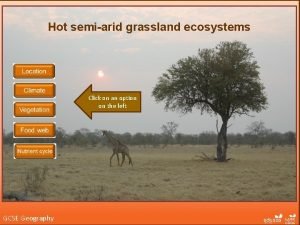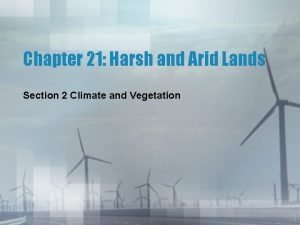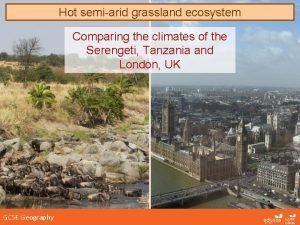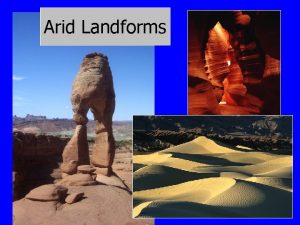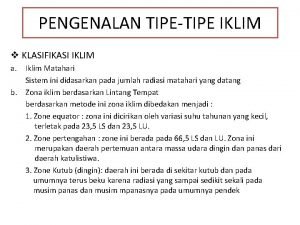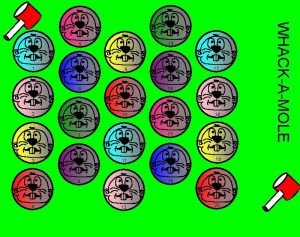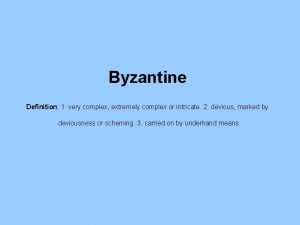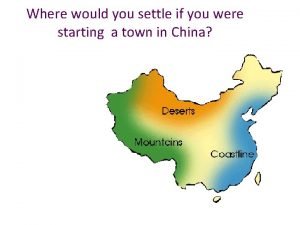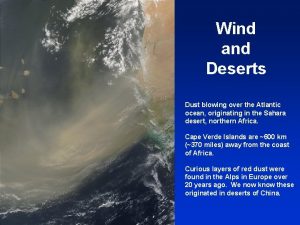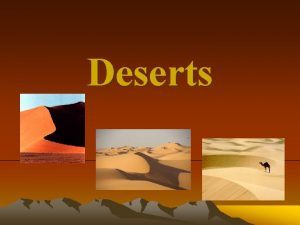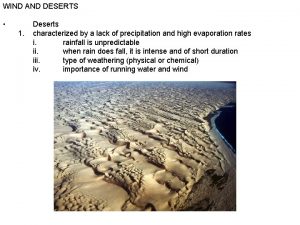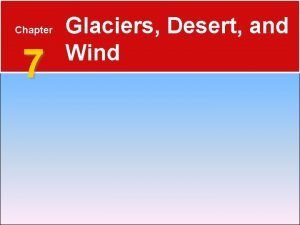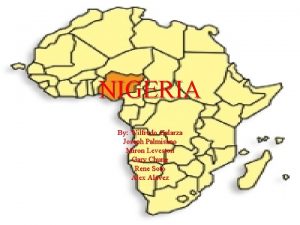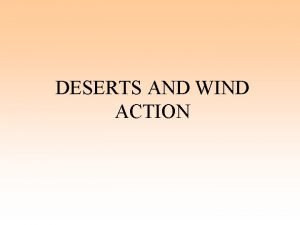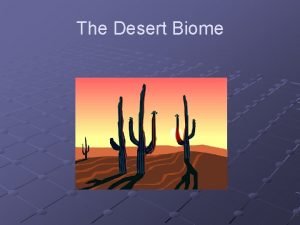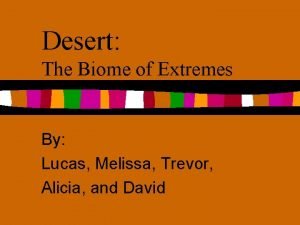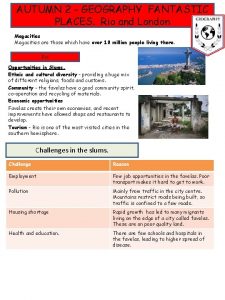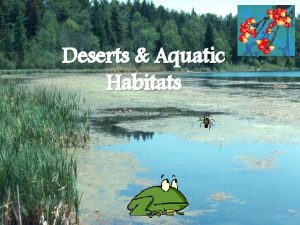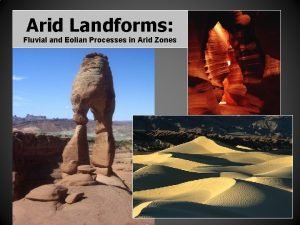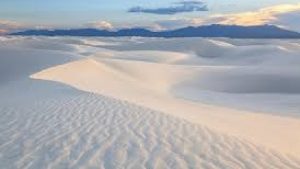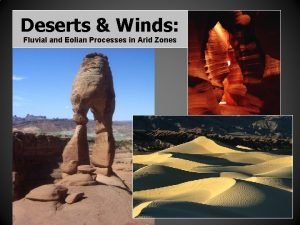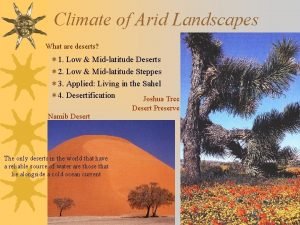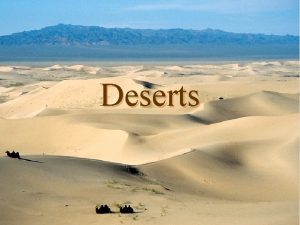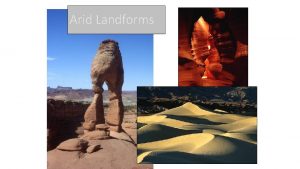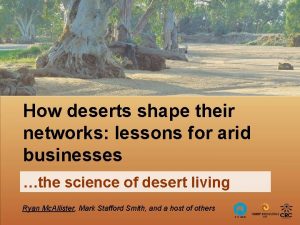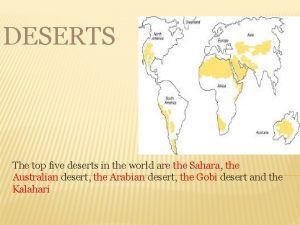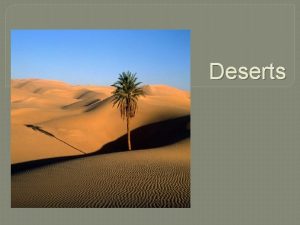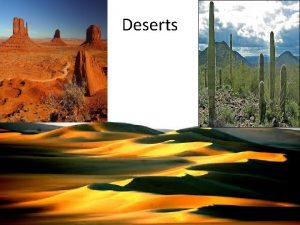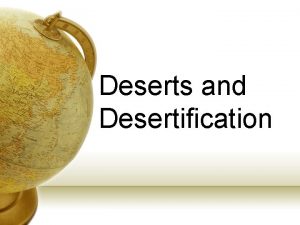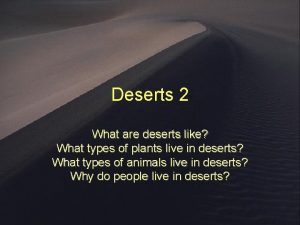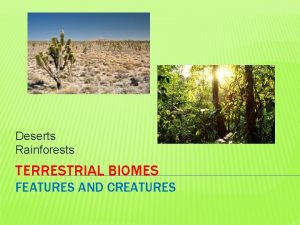Deserts are extremely dry arid places True deserts




























































- Slides: 60










• Deserts are extremely dry (arid) places. • True deserts normally have less than 250 mm a year, although some deserts like the Atacama to the right can go years without any water. • Deserts are very dry because the air that descends over them is very dry

• • The air is dry because most of the moisture has fallen as precipitation over the Equator (tropical rainforests) before being pushed out and falling near the tropics. The air is also very dry because the air travelling from the equator to the tropics travels over land not the sea. This means that no additional moisture is picked up. Because there is no moisture in the air, there are very few clouds in deserts which means desert areas are exposed to high levels of incoming radiation from the sun. This means that daytime temperatures in the desert are very high. However, the lack of cloud cover also means that a lot of outgoing radiation is able to escape, making desert temperatures very cold at night presence of high pressure creates cloud-free conditions mountain ranges create RAIN SHADOWS

NO CLOUDS!!!!










Succulents e. g. cacti: Succulents tend to be fairly fat fleshy (carnoso) plants that are able to store water in their leaves, trunks and roots.

Ephemeral: These are plants with very short life cycles - typically 6 -8 weeks. This means that they can take advantage of very short wet seasons in order to pollinate. desert plants that grow, flower, and set seed in brief periods of rain. then came back in a more or less long dormancy phase.

Long and wide roots: Plants in deserts have very long roots so that they are able to absorb the maximum amount of rainfall during periods of rainfall. It also makes them more stable in very lose soil. Shallow enaugh to reach the water of rainfall




Spiky (spinose) and waxy (cerose) surface • Many plants like cacti protect themselves with spikes and wax so that they are not eaten or damaged by animals. • Lustrous, shiny leaves are not only visually attractive but have a practical purpose. • Plants often grow a waxy coating as protection against certain environmental factors. • Waxy coatings are barriers between the leaf and the environment, and they can help the plant retain moisture in hot environments. • The coatings can also deflect the rays of the sun to keep the plant from transpiring too quickly, and may also discourage pathogens, like fungi and bacteria, from entering the leaves.

Succulents e. g. cacti: Succulents tend to be fairly fat fleshy (carnoso) plants that are able to store water in their leaves, trunks and roots. Ephemeral: These are plants with very short life cycles - typically 6 -8 weeks. This means that they can take advantage of very short wet seasons in order to pollinate. Long and wide roots: Plants in deserts have very long roots so that they are able to absorb the maximum amount of rainfall during periods of rainfall. It also makes them more stable in very lose soil. Spiky (spinose) and waxy (cerose) surface: Many plants like cacti protect themselves with spikes and wax so that they are not eaten or damaged by animals. Lustrous, shiny leaves are not only visually attractive but have a practical purpose. Plants often grow a waxy coating as protection against certain environmental factors. Waxy coatings are barriers between the leaf and the environment, and they can help the plant retain moisture in hot environments. The coatings can also deflect the rays of the sun to keep the plant from transpiring too quickly, and may also discourage pathogens, like fungi and bacteria, from entering the leaves.

Which animals live in the desert? Animals in the desert must survive the intense heat, searing sun, and lack of water. Animals that live in the hot desert have many adaptations. Some animals never drink, but get their water from seeds (some can contain up to 50% water) and plants. Many animals are nocturnal, sleeping during the hot day and only coming out at night to eat and hunt. Some animals rarely spend any time above ground.

THE THORNY DEVIL DRINKS WITH ITS SKIN. The thorny devil has developed skin that can absorb water like blotter paper (carta assorbente) (called “capillary action”). The way the scales (squame) on the body are structured, it collects dew and channels it down to the corners of the mouth.

Big Ears Act Like Radiators. The fennec fox of North Africa • has large ears which serve a dual purpose: • they are great for listening for bugs (insetti) to eat that may be moving around underground; • they are also loaded with blood vessels, allowing the animals to dissipate excess body heat. • While big ears are wonderful radiators during hot days, the fox’s thick fur coat also acts as insulation during cold desert nights.

The Camel Is a Living Desert Adaptation. The hump stores fat, which can be used as both a food and water source. Camels also have thick hairs in their ears for keeping out sand, and the same can be said of their eyelashes wide feet that act snowshoes in the sand. like

Scorpions Can Slow Their Metabolic Rate, allowing them to “Hibernate” While Awake.

Some of the animals that live in the desert. A sidewinder is a small agile snake. It is mainly nocturnal and takes shelters from the heat of the day in the burrow (cunicolo) of another animal or under a bush. The fat sand rat overcomes the problem of the unpredictability of desert food supplies • by laying down a thick layer of fat all over its body when there is plenty of food It then lives off this fat when food is short. • Active day and night, collects seeds which it carries back to its burrow.









Human Threats • Even though deserts are very hot arid environments that normally have very low population densities, humans can still threaten them. Some of the threats caused by humans include: • Extraction of resources e. g. copper (rame) in the Atacama Desert • Hunting e. g. Oryx (antilopi) and Cheetah (grandi felini es. ghepardi) in the Namib Desert • Tourists damaging dunes e. g. dune boarding and desert bashing (gara di fuoristada )in the Arabian Desert • Overgrazing killing what little vegetation there is and overcultivation e. g. Southern Sahara • Deforestation: There is limited vegetation in deserts, but often it is removed for fuel or to make space for crops • Toyotarisation: 4 X 4 vehicles being driven across the desert disturbing animals, killing vegetation and creating dust storms

Physical Causes of Desertification • Rising Temperatures: As global temperatures increase it is becoming increasingly hard for vegetation to grow thus reducing vegetation cover and increasing the risk of wind and water erosion. • Falling Rainfall: As the amount of rainfall reduces in some areas like the Sahel, then it is increasingly hard for vegetation to grow again making the ground more vulnerable to wind and water erosion. • Flash floods: Intense periods of rainfall can also cause erosion of topsoil which leads to land degradation. • Wind: If a region is particularly windy then the amount of wind erosion is likely to increase.















 Antigentest åre
Antigentest åre Arid region with sparse to almost noneexistent vegetation
Arid region with sparse to almost noneexistent vegetation R madarid
R madarid Diagram iklim koppen
Diagram iklim koppen Marine west coast climograph
Marine west coast climograph Hot semi arid grassland
Hot semi arid grassland Chapter 21 harsh and arid lands
Chapter 21 harsh and arid lands Types of grasslands comparing climatographs
Types of grasslands comparing climatographs Arid landforms
Arid landforms Iklim humid
Iklim humid 102 dr
102 dr Chapter 2 jesus christ true god and true man
Chapter 2 jesus christ true god and true man Hrllp
Hrllp Extremely
Extremely Invert the subject and verb with place expressions
Invert the subject and verb with place expressions Extremely
Extremely Contains graphic content
Contains graphic content Natural selection will ultimately make a species
Natural selection will ultimately make a species Lindsey is extremely afraid of becoming obese
Lindsey is extremely afraid of becoming obese Byzantine definition
Byzantine definition Iso 9000 2015 pdf
Iso 9000 2015 pdf World desert map
World desert map Food deserts in minnesota
Food deserts in minnesota Deserts
Deserts Characteristics of deserts
Characteristics of deserts How are deserts formed
How are deserts formed What are deserts
What are deserts What is a desert
What is a desert Deserts
Deserts Chapter 7 glaciers deserts and wind
Chapter 7 glaciers deserts and wind Desert rap
Desert rap Nigerian deserts
Nigerian deserts Wind action in desert
Wind action in desert Rain shadow deserts
Rain shadow deserts Desert biome climate
Desert biome climate Adaptation of cactus
Adaptation of cactus Ancient china map taklamakan desert
Ancient china map taklamakan desert People and places
People and places Unit 1 people and places
Unit 1 people and places Materi bahasa inggris kelas 6 public places
Materi bahasa inggris kelas 6 public places Famous places in lithuania
Famous places in lithuania Allez vous en sur les places
Allez vous en sur les places Australias capital
Australias capital Kirsten places her surveyor's telescope
Kirsten places her surveyor's telescope Holy places
Holy places Fantastic places geography
Fantastic places geography Incremental decision process model
Incremental decision process model Who has defined style as proper word in proper places
Who has defined style as proper word in proper places How and why are places similar
How and why are places similar Human geography places and regions in global context
Human geography places and regions in global context Elastic potential energy ex
Elastic potential energy ex Point lagrange
Point lagrange People and places
People and places Why do languages vary among places
Why do languages vary among places Upper bound and lower bound 2 significant figures
Upper bound and lower bound 2 significant figures Fricative sounds
Fricative sounds Carl herold programmer
Carl herold programmer Tectonic plates interact at places called plate
Tectonic plates interact at places called plate Playgrounds are such pushy places ,know what i mean?
Playgrounds are such pushy places ,know what i mean? Describing places exercises
Describing places exercises Quickly comparative
Quickly comparative





